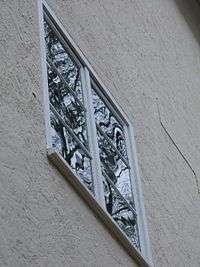Soda-lime glass


Soda-lime glass, also called soda-lime-silica glass, is the most prevalent type of glass, used for windowpanes and glass containers (bottles and jars) for beverages, food, and some commodity items. Glass bakeware is often made of tempered soda-lime glass.[1] Soda-lime glass accounts for about 90% of manufactured glass.
Soda-lime glass is relatively inexpensive, chemically stable, reasonably hard, and extremely workable. Because it can be resoftened and remelted numerous times, it is ideal for glass recycling.[2]
Soda-lime glass is prepared by melting the raw materials, such as sodium carbonate (soda), lime, dolomite, silicon dioxide (silica), aluminium oxide (alumina), and small quantities of fining agents (e.g., sodium sulfate, sodium chloride) in a glass furnace at temperatures locally up to 1675 °C.[3] The temperature is only limited by the quality of the furnace superstructure material and by the glass composition. Relatively inexpensive minerals such as trona, sand, and feldspar are usually used instead of pure chemicals. Green and brown bottles are obtained from raw materials containing iron oxide. The mix of raw materials is termed batch.
Soda-lime glass is divided technically into glass used for windows, called flat glass, and glass for containers, called container glass. The two types differ in the application, production method (float process for windows, blowing and pressing for containers), and chemical composition. Flat glass has a higher magnesium oxide and sodium oxide content than container glass, and a lower silica, calcium oxide, and aluminium oxide content.[4] From the lower content of highly water-soluble ions (sodium and magnesium) in container glass comes its slightly higher chemical durability against water, which is required especially for storage of beverages and food.
Typical compositions and properties
.svg.png)
The following table lists some physical properties of soda-lime glasses. Unless otherwise stated, the glass compositions and many experimentally determined properties are taken from one large study.[4] Those values marked in italic font have been interpolated from similar glass compositions (see calculation of glass properties) due to the lack of experimental data.
| Properties | Container glass | Flat glass | ||||||||||||||||||||||||||||||||||||||||
|---|---|---|---|---|---|---|---|---|---|---|---|---|---|---|---|---|---|---|---|---|---|---|---|---|---|---|---|---|---|---|---|---|---|---|---|---|---|---|---|---|---|---|
| Chemical composition, wt% |
|
| ||||||||||||||||||||||||||||||||||||||||
| Viscosity log(η, dPa·s or Poise) = A + B / (T in °C − To) |
|
| ||||||||||||||||||||||||||||||||||||||||
| Glass transition temperature, Tg |
573 °C (1,063 °F) | 564 °C (1,047 °F) | ||||||||||||||||||||||||||||||||||||||||
| Coefficient of thermal expansion, ppm/K, ~100–300 °C (212–572 °F) |
9 | 9.5 | ||||||||||||||||||||||||||||||||||||||||
| Density at 20 °C (68 °F), g/cm3 |
2.52 | 2.53 | ||||||||||||||||||||||||||||||||||||||||
| Refractive index nD at 20 °C (68 °F) |
1.518 | 1.520 | ||||||||||||||||||||||||||||||||||||||||
| Dispersion at 20 °C (68 °F), 104×(nF−nC) |
86.7 | 87.7 | ||||||||||||||||||||||||||||||||||||||||
| Young's modulus at 20 °C (68 °F), GPa |
72 | 74 | ||||||||||||||||||||||||||||||||||||||||
| Shear modulus at 20 °C (68 °F), GPa |
29.8 | 29.8 | ||||||||||||||||||||||||||||||||||||||||
| Liquidus temperature |
1,040 °C (1,900 °F) | 1,000 °C (1,830 °F) | ||||||||||||||||||||||||||||||||||||||||
| Heat capacity at 20 °C (68 °F), J/(mol·K) |
49 | 48 | ||||||||||||||||||||||||||||||||||||||||
| Surface tension, at ~1,300 °C (2,370 °F), mJ/m2 |
315 | |||||||||||||||||||||||||||||||||||||||||
| Chemical durability, Hydrolytic class, after ISO 719[6] |
3 | 3...4 | ||||||||||||||||||||||||||||||||||||||||
| Critical stress intensity factor,[7] (KIC), MPa.m0.5 |
? | 0.75 |
- Coefficient of restitution (glass sphere vs. glass wall): 0.97 ± 0.01[8]
- Thermal conductivity: 0.7-1.3 W/m.K[9]
- Hardness (Mohs scale): 6[10]
- Knoop hardness: 585 kg/mm2 + 20
See also
References
- ↑ "Pyrex Manufacturing History". World Kitchen Inc. Retrieved 2009-06-09.
- ↑ "Calcium Carbonate - Glass Manufacturing". congcal.com. congcal. Retrieved 5 August 2013.
- ↑ B. H. W. S. de Jong, "Glass"; in "Ullmann's Encyclopedia of Industrial Chemistry"; 5th edition, vol. A12, VCH Publishers, Weinheim, Germany, 1989, ISBN 3-527-20112-2, p 365-432.
- 1 2 "High temperature glass melt property database for process modeling"; Eds.: Thomas P. Seward III and Terese Vascott; The American Ceramic Society, Westerville, Ohio, 2005, ISBN 1-57498-225-7
- ↑ "Sodalime Optical Glass – Internal transmittance (2 mm)". vpglass.com. Archived from the original on 2011-09-09. Retrieved 2013-08-24.
- ↑ "ISO 719:1985 - Glass -- Hydrolytic resistance of glass grains at 98 degrees C -- Method of test and classification". iso.org.
- ↑ Wiederhorn, S.M. (1969). "Fracture stress energy of glass". Journal of the American Ceramic Society. 52 (2): 99–105. doi:10.1111/j.1151-2916.1969.tb13350.x.
- ↑ Gondret, P.; M. Lance; L. Petit (2002). "Bouncing Motion of Spherical Particles in Fluids". Physics of Fluids. 14 (2): 643–652. doi:10.1063/1.1427920.
- ↑ Janssen, L.P.B.M., Warmoeskerken, M.M.C.G., 2006. Transport phenomena data companion. Delft: VVSD.
- ↑ "Soda-Lime (Float) Glass Material Properties :: MakeItFrom.com". makeitfrom.com.